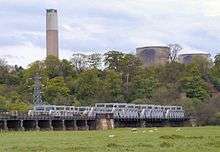Trent Viaducts
| Trent Viaducts | |
|---|---|
 Trent Viaducts as rebuilt around 1901 | |
| Coordinates | 52°52′25″N 1°15′58″W / 52.873484°N 1.266166°WCoordinates: 52°52′25″N 1°15′58″W / 52.873484°N 1.266166°W |
| Crosses | River Trent |
| Owner | Network Rail |
| Maintained by | Network Rail |
| Characteristics | |
| Total length | 600ft |
| Width | 40ft |
| Longest span | 100ft |
| Clearance above | 22ft |
| History | |
| Architect | Charles Blacker Vignoles |
| Fabrication by | Butterley Company |
| Construction begin | June 1838 |
| Opened | 1839 |

Trent Viaduct as shown in the Midland Counties' Railway Companion of 1840
Trent Viaducts are two adjacent parallel railway bridges which carry the Midland Main Line over the River Trent between Derbyshire and Nottinghamshire.
Originally a single bridge, it was built by the engineer Charles Blacker Vignoles for the Midland Counties Railway in 1839.[1]
The Viaduct was rebuilt in 1901 when a second crossing was added by the Midland Railway to carry the high-level goods line from Toton. The rebuilding included the removal of the cast iron spans supplied by the Butterley Company. The additional line opened on 2 June 1901.[2]
On the Midland Railway System Maps of 1918, the bridges are identified as bridges 27 and 27a.[3]
Just south of the viaducts are twin tunnels through Red Hill.
| Next crossing upstream | River Trent | Next crossing downstream |
| Harrington Bridge | Trent Viaducts | Clifton Bridge |
References
- ↑ The Rise of the Midland Railway 1844-1874. E. G. Barnes, Augustus M. Kelley, New York, 1969. SBN 678060002
- ↑ "Midland Railway Company". Derby Daily Telegraph. Derby. 2 August 1901. Retrieved 22 May 2016.
- ↑ Midland Railway System Maps, distance diagrams, Sheet 13b. 1918
This article is issued from Wikipedia - version of the 5/22/2016. The text is available under the Creative Commons Attribution/Share Alike but additional terms may apply for the media files.